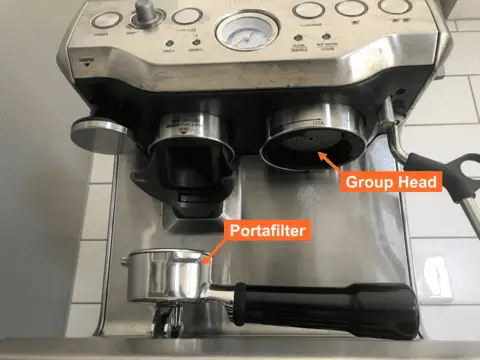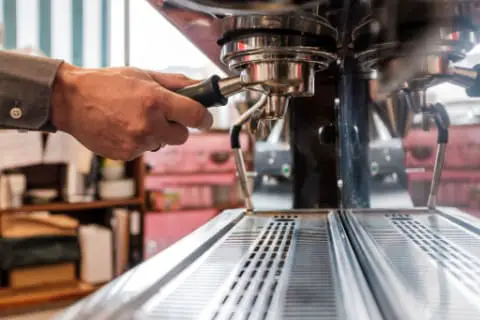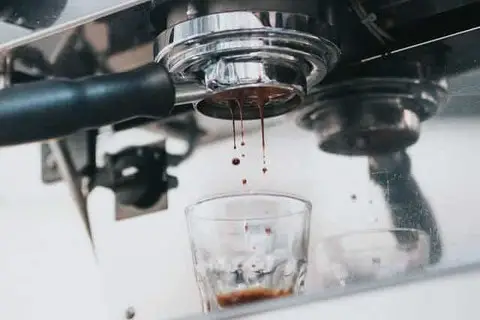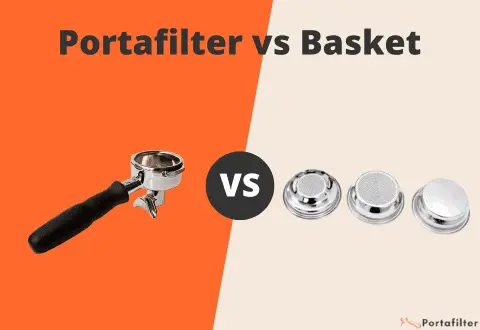As an Amazon Associate I earn from qualifying purchases. When you use our links, we may earn an affiliate commission. Learn more.
When you own an espresso machine, it’s a good idea to learn the name of the components and what each one does. Two of the most critical elements are the group head and the portafilter. While they can look similar, they each serve a distinct role.

So, what are the distinctions between a group head and a portafilter?
Portafilter vs Group Head: 4 Key Differences
| Group Head | Portafilter | |
| Purpose | Sprays the water onto the beans | Holds the grounds and releases coffee into the cup |
| Maintenance required | Changing seals, occasional cleaning | Needs to be removed and replaced |
| Role in the coffee maker | Pipes connect it to the boiler | Slots into the group head |
| Removable | No | Yes |
While this is a quick overview of the critical differences, it is worth diving deeper into each component.
By learning more about these elements, you can also learn how to optimize your machine to get the best performance. Keep reading to learn the basics of group heads and portafilters.
What Is A Group Head?

The group head is the component that the portafilter attaches to. It will be responsible for dispersing the water onto the grounds. To do this effectively, it needs to ensure that all the water is sprayed evenly. If you use a non-pressurized portafilter, the group head will also be responsible for regulating water pressure.
Why Is It Called a Group Head?
To understand this, we need to know a little about Italian culture. The word “group” is often used to refer to a series of mechanical connections, like the engine in a car or the gear system of a bike. This also applies to the complex series of pipes and valves that culminate in the group head.
There are a few other names the group head might be known by. These include:
- Brew head
- Brew group
- Espresso machine group
What Are Some Group Head Types?
Like portafilters, there are multiple types of group heads. Here are some of the most common options:
- Saturated. This type of group head will be connected directly to the boiler. This will provide more steady water temperatures.
- Semi-saturated. This will be connected to the boiler through pipes. While this can mean that water temperatures will be a little more unstable, these systems will be a lot easier to repair if something goes wrong.
- Electrically heated. These group heads contain electric elements in the group head to heat the water. A thermometer will help you maintain the right temperature.
- Lever. This will require you to physically pull a lever. Sometimes, they will be manual. This will give you control over the amount of force you are putting on the ground. At other times, it will be a spring lever, where the piston regulates the amount of pressure going through the system.
- Multiple group head sizes. You can customize the group head size to suit the portafilter. For example, if you want a machine serving two or more shots at once, you will need a double-shot group head. At other times, there might be multiple group heads in a machine.
This free cheat sheet will improve your coffee brew by providing quick information on brew ratio, grind size, optimal brewing time, and more.
How Does An Espresso Group Head Work?

There are a few essential things that a group head needs to do. These include:
- Pressurizing the water. In most cases, the group head will have small holes. The water is forced through these at high speed. This creates pressure within the portafilter, which is required to extract the flavor from the beans.
- Showering the beans. The water flow is known as a shower. Most of the time, it lasts between 10 to 30 seconds.
- Distributing the water. The group head must ensure that all the beans are showered with water equally.
Do You Leave The Portafilter In The Group Head?

It is common to leave the portafilter in the machine when you aren’t using it. This serves two purposes. First, it ensures that it’s already warm when you want to start making coffee. This will help you extract the oil from the coffee beans for a superior taste. Secondly, it ensures you don’t accidentally misplace it in your kitchen.
How Long Do Group Heads And Portafilters Last?
You will need to perform a little maintenance to keep your coffee maker in good condition. How often you need to do this will depend on how frequently you use the machine.
Usually, the group head will be reasonably easy to care for.
You will need to replace the seal. This will need to be done every three to six months. But it’s rare for the whole system to need to be replaced.
Over time, the hole in the bottom of the portafilter will grow larger.
But this is a slow process. Often, you’ll need to replace the basket every six months to a year.
What Are Portafilters?

Portafilters are responsible for holding the beans during the brewing process. They are often little baskets that the grounds sit in. It will usually be attached to a handle.
This component will slot into the group head.
When making the coffee, the water will flow into the portafilter and mix with the grounds, extracting the flavor. It will then run into the series of holes in the bottom of the portafilter basket, ending up in your cup.
What Are Some Types of Portafilters?
There are a few types of portafilters available on the market. These include:
- Pressurized. These have smaller holes, allowing the water pressure to build up inside the portafilter.
- Non-pressurized. These rely on the machine building up the pressure. Non-pressurized portafilters are the most common option because they make a more decadent, full-bodied coffee.
- Spouted. These contain a funnel, which you can use to channel the coffee. These are the best option if you plan on splitting the shot.
- Naked. Naked or “bottomless” portafilters don’t have a spout, allowing the coffee to drip from the base of the portafilter basket into the cup.
It should be noted that you can get some variation in sizing, depending on the machine. But most will be 58mm. If you would like to learn more then please refer to this essential portafilters guide.
Final Thoughts
The group head and the portafilter have important roles to play in the functioning of a coffee maker. The group head will spray the water over the top of the beans.
On the other hand, the portafilter will hold the beans as the water extracts the flavor and flows into your cup. At the end of this process, you’ll be able to enjoy a delicious brew.
This free cheat sheet will improve your coffee brew by providing quick information on brew ratio, grind size, optimal brewing time, and more.


